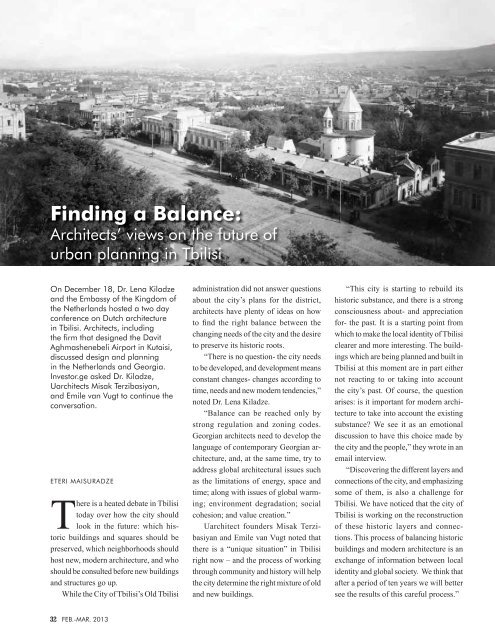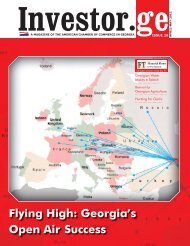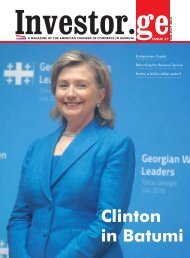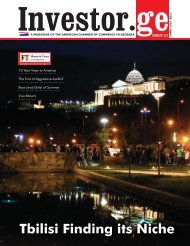There is a heated debate in Tbilisitoday over how the city shouldlook in the future: which historicbuildings and squares should bepreserved, which neighborhoods shouldhost new, modern architecture, and whoshould be consulted before new buildingsand structures go up.While the City of Tbilisi’s Old Tbilisiadministration did not answer questionsabout the city’s plans for the district,architects have plenty of ideas on howto find the right balance between thechanging needs of the city and the desireto preserve its historic roots.“There is no question- the city needsto be developed, and development meansconstant chan<strong>ge</strong>s- chan<strong>ge</strong>s according totime, needs and new modern tendencies,”noted Dr. Lena Kiladze.“Balance can be reached only bystrong regulation and zoning codes.Georgian architects need to develop thelangua<strong>ge</strong> of contemporary Georgian architecture,and, at the same time, try toaddress global architectural issues suchas the limitations of energy, space andtime; along with issues of global warming;environment degradation; socialcohesion; and value creation.”Uarchitect founders Misak Terzibasiyanand Emile van Vugt noted thatthere is a “unique situation” in Tbilisiright now – and the process of workingthrough community and history will helpthe city determine the right mixture of oldand new buildings.“This city is starting to rebuild itshistoric substance, and there is a strongconsciousness about- and appreciationfor- the past. It is a starting point fromwhich to make the local identity of Tbilisiclearer and more interesting. The buildingswhich are being planned and built inTbilisi at this moment are in part eithernot reacting to or taking into accountthe city’s past. Of course, the questionarises: is it important for modern architectureto take into account the existingsubstance? We see it as an emotionaldiscussion to have this choice made bythe city and the people,” they wrote in anemail interview.“Discovering the different layers andconnections of the city, and emphasizingsome of them, is also a challen<strong>ge</strong> forTbilisi. We have noticed that the city ofTbilisi is working on the reconstructionof these historic layers and connections.This process of balancing historicbuildings and modern architecture is anexchan<strong>ge</strong> of information between localidentity and global society. We think thatafter a period of ten years we will bettersee the results of this careful process.”
The steadily growing number offoreigners traveling to Georgiais stimulating growth in the hotelsector, according to two recent reports onthe industry.Two hotel sector studies – the GRE-MO report by Jones Lang LaSalle/IPMand the monthly review by KPMGGeorgia – both found that the numberof guests is increasing, as is investmentsin the sector.“According to the data provided bythe Border Police of Georgia, 4,389,256foreigners visited Georgia in 2012 - representinga 56 percent increase comparedto 2011,” noted the KPMG report, whichcited better visa regimes with Turkey andRussia for some of the increase.“If the political situation remainsstable, a 10 percent annual increase inthe number of visitors to Tbilisi in 2012-2016 is expected.”While the GREMO report noted thatonly 30 percent of the total number oftourists arriving in Georgia register inhotels, that number is steadily growing– meaning higher occupancy rates forhotels in 2012.“In the past five years, the numberof registered guests in accommodationfacilities has almost quadrupled andreached 853,049 in 2011,” it stated.Hotels in Tbilisi note 2012 was aneven better year, with occupancy ratesas high as 80 percent for hotels likethe Sheraton Metechi Palace Hotel, accordingto General Mana<strong>ge</strong>r AndreasHeidingsfelder.An estimated 75 percent of theSheraton’s guests are business travelers,but Heidingsfelder is optimistic about anincrease in tourists, as well.“If the political situation is stableand there is no big chan<strong>ge</strong>, and it goessmoothly further, the tourists will come,”he said. “There is so much advertisementfor Georgia – unexpected advertisement,not done now by the Department of Tourismor the Ministry of Economy – it isdone for the interest of country. For examplein November there was one weekof Georgian focus on German TV…Theysee that people are interested in Georgia.”The Holiday Inn, the newest chainhotel on the market - and the lar<strong>ge</strong>st, wasquick to find a niche in Tbilisi for its 252beds, noted Oto Berishvili, the hotel’sbusiness development mana<strong>ge</strong>r.“We opened our hotel at the end of2010… we grabbed our market sharebecause the quality and standards andservice we have is really in proportionwith the price we have,” he said.“Of course, there was a hu<strong>ge</strong> increasein 2012 compared to 2011, because it wasalready our second year and we alreadyhad a lot of accounts and a lot of satisfiedand loyal guests and companies.”Steady growth is bolstering demandfor hotel rooms in Tbilisi, according tothe Jones Lang LeSalle/IPM and KPMGreports.The Jones Lang LaSalle/IPM report,published in December 2012, found thatthe number of guests staying in hotelrooms increased 140 percent over thepast three years, from 2009 to 2012. Bycomparison, new hotel rooms have beenslow to hit the market, with the numberof beds growing by just 38 percent overthe same period.KPMG reported the growing demandfor hotels has inspired a steady increasein investment in the sector over the pastdecade: there are currently five hotelprojects in the works including a HiltonGarden, Intercontinental, Rixos Hoteland the Golden Tulip.“In 2007-2011, investments in fixedassets in the hotel, restaurant and catering







